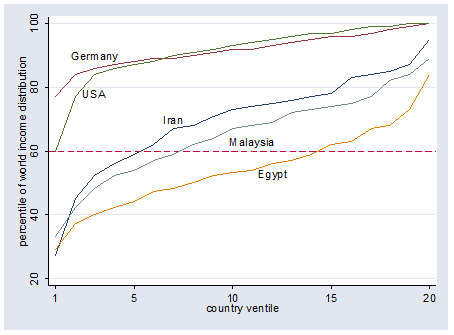Iran’s place in the world distribution of income
Branko Milanovic is a leading authority on the global distribution of income. His influential 2005 book, Worlds Apart provided the most comprehensive account of how global inequality has evolved over time. He has just completed the sequel (The Haves and the Have-Nots, Basic Books, forthcoming), which updates his earlier analysis using survey data on income and expenditures from 119 countries for 2005. He finds that despite rapid economic growth in China and India, two very large and poor countries, in recent years global inequality has remained constant and very high (Gini index = 0.80). I asked him to help me understand where Iran was located in the global distribution of income, and he produced this amazing graph.
To read this graph, note that on the vertical axis is the position of a person in the world distribution of income and on the horizontal axis her position in her country. So, for example, the person with median income in Iran (10th ventile) is approximately at the 75% percentile of the world distribution and the same person from Germany is above the 90% percentile of the world distribution.
How surprised you are by what you see here depends on your priors about inequality in the countries included in this graph. Few readers familiar with the United States will be surprised to learn that the poorest person in the US, who occupies the 60th percentile in the global income distribution, is much poorer than the poorest person in Germany (or even Spain–not shown here). As one of the richest countries in the world, the United States is notorious for its underclass, which is in part racially defined. Interestingly, beyond the poorest decile, Americans and Germans look nearly identical from the viewpoint of income.
It may surprise more people that the poorest person in the US has about the same income as the Iranian located at the 20% percentile. So, if the poorest person in the US visited Iran, he or she would have reason to envy the living standard of 80% of Iranians, whereas the same person from Germany would feel worse off only compared to the top one-third of Iranians.
What may surprise many — it certainly surprised me — is that Iran’s distribution of income (in 2005) looks worse than that of the US, even though the two countries have about similar Gini indices of inequality–in the 0.40-0.45 range. In fact, Iran appears to have just about the worst distribution in this group of countries. The graph shows that most of the inequality in the US is the result of severe poverty, whereas Iran’s inequality is caused by inequality at he two extreme ends of the distribution, the very poor and the very rich. Iran’s poor are worse off than the poor in Egypt and Malaysia, while its rich are represented in the top decile of the world’s income distribution.
Iran is not all that unequal compared to most other countries, especially those in Latin America (Brazil’s Gini=0.60) and Sub-Saharan Africa. The graph below (also from Milanovic) depicts the Gini index of all the countries with requisite data against the so-called Kuznets curve, which relates inequality to the country’s income per capita (measured in 2005 PPP dollars). Iran is not only more unequal than other Middle Eastern countries, such as Egypt, Jordan, Morocco and Syria, it is also located above the curve, which means that it is more unequal than warranted by its income–not to mention the social justice ideals of the 1979 Islamic Revolution.



Dear Mr Salehi. Where we can find income distribution graph for all countries. Is there any online source available that you could offer the link. Is there any interactive graph? What about data sets?
Nothing with graphs or micro data comes to mind. World Development Indicators has the Gini index and a few other indicators of inequality for many countries.
[…] آن کشور در سطوح نابرابرتر درآمدی زندگی میکنند. مثلا در اینجا دکتر جواد صالحی بر اساس همین منطق توضیح داده است که وضع […]
[…] و ترجمه شده، که در آدرس اینترنتی زیر قابل دسترسی است: Iran’s place in the world distribution of income برانکو میلانوویک از برجستهترین اقتصاددانان […]
Actually Iran’s Gini has been declining since 2005 as per UN HDR. It is now I guess at 36. Ofcourse there are alot of big fish in Iran but they are more and more becoming irrelevant politically and isolated from decision making. These oligarchs time is over. There are poor in Iran but one has to remember that poverty never goes away ever without progress in indigenous science and technology, and this Iran is doing well in. In fact as pointed out by sciencemetrix report, Iran has the world’s fastest growth rate in science and technology.
I am not sure where UN HDR gets its numbers. I do not trust them. For years they have been saying poverty in Iran is about 20% despite all evidence to the contrary. I have not seen evidence of a declining trend in in inequality. In the numbers I have seen and worked with, it only fell in 2008 and that was because of the recession, which is hardly reason for celebration.
[…] در باب جایگاه ایران در توزیع جهانی درآمد (+) که چند نکته بسیار مهم دارد؛ اول اینکه درآمد 75 درصد […]
http://www.bbc.co.uk/persian/business/2010/06/100608_l01_tehran_poverty.shtml?keepThis=true&TB_iframe=true&height=700&width=990
The most interesting part was that a large percent of people in two divisions are in top three percentiles.
what happened to my comment?!
I put it last night and I come to see your answer. Anyway I think that the horizontal axis in the second graph seems to be growth rate of some income expenditure index instead of level of income/expenditure.
Thnaks for your comment. The hosrizontal axis is not a growth rate; it is the position of a person’s income in the distribution of income in the country. The level of income is relfected in the position of the country’s graph relative to others. I hope this answers your question.
As mentioned by Hojat, the horizontal axis looks weird. It looks more like the growth of some income/expenditure measure, otherwise it means that Iran is among top first fifth of GDI countries in the world!
Take a look at these two graphs:
1: GNI per capita PPP:
http://www.google.com/publicdata/explore?ds=d5bncppjof8f9_&ctype=l&strail=false&nselm=h&met_y=ny_gnp_pcap_pp_cd&scale_y=lin&ind_y=false&rdim=country&idim=country:EGY:IRN:MYS:JOR:MAR:SYR&tdim=true&tstart=315532800000&tunit=Y&tlen=28&hl=en&dl=en&iconSize=0.5&uniSize=0.03500000000000003
2. GDP per capita growth
http://www.google.com/publicdata/explore?ds=d5bncppjof8f9_&ctype=l&strail=false&nselm=h&met_y=ny_gdp_mktp_kd_zg&scale_y=lin&ind_y=false&rdim=country&idim=country:IRN:EGY:JOR:MAR:SYR&tdim=true&tstart=946684800000&tunit=Y&tlen=8&hl=en&dl=en&iconSize=0.5&uniSize=0.034999999999999976
Bahar,
This is a very good comment and highlights some of the issues of household survey (HS) data. The situation is as follows. I do not ‘gross up” HS data to any national account aggregate. Each value in the graph is just mean income (or expenditure) for that ventile converted using PPP rate for the country. Now, your point re. Malaysia vs. Iran is well taken: Malaysia’s GDP per capita (in PPP) in 2005 is some 25% higher than Iran’s. Both HS use income per capita aggregate. That disposable income is not equivalent to GDP per capita because (by definition) it excludes direct taxes (which finance education, health, govt administration), retained profits, stock inventories. But in addition it may diverge from GDP per capita because of lack of participation of the rich, missing out of property income and the like. So, HS income/GDP is not a great measure nor do we expect (theoretically, even it should not be) to be equal to 1. But we do expect HS mean/per capita consumption from NA to be close to 1 in the case of HSs that use consumption, and not too far from 1 in the case of those that use income (as here). In the event, Iranian surveys do much better: the ratio HS mean/NA consumption is almost exactly 1 and in Malaysia, it is 0.6. Now, is this due to Iranians paying less direct taxes, or capturing better the rich in the data, or just having a better survey, I do not know. It is true thought that Malaysia’s surveys are somewhat of an outlier in Asia: the average capture ratio in Asia is 0.73, and Malaysia’s is 0.6.
Very interesting.
But one thing in the graph doesn’t seem right. Compare to Iran, Malaysia has a higher GDP (ppp and nominal). Than means it’s impossible for Iran’s graph to be over the Malaysia’s one for almost all of those ventiles.
You raise is a good point. You are right, Malaysia’s GDP per capita is about 20% higher than Iran’s. I am not really sure how Milanovic scales the distribution graphs. I believe he uses per capita expenditures from survey data, not GDP per capita. In that case, especially given the low savings rate of Iranians, it may make sense for Iran’s graph to be above Malaysia’s.
it may mean that the amoount of the ppl who are below than than that of Malaysia in the graph are more , thats the number of poors are more. Therefore the gdp per capita is less.
the population factor is totally removed by using ‘per capita’ data. you obviously did not understand the graph.